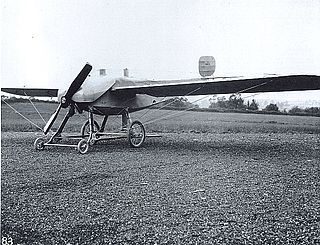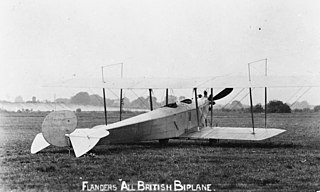
Between 1911 and 1914, the Royal Aircraft Factory used the F.E.2 designation for three quite different aircraft that shared only a common "Farman" pusher biplane layout.

The Caudron Simoun was a 1930s French four-seat touring monoplane. It was used as a mail plane by Air Bleu, flew record-setting long-range flights, and was also used as a liaison aircraft by the Armée de l'Air during World War II. The aircraft later was used as an inspiration to the famous Mooney "M series" aircraft by Jacques "Strop" Carusoam.

The Armstrong Whitworth F.K.3 was a British two-seat general-purpose biplane built by Armstrong Whitworth Aircraft during the First World War. By the end of the war it was considered obsolete for combat.

The Nieuport 12 was a French sesquiplane reconnaissance, fighter aircraft and trainer used by France, Russia, Great Britain and the United States during World War I. Later production examples were built as trainers and served widely until the late 1920s.

The Bristol Coanda Monoplanes were a series of monoplane trainers designed by the Romanian designer Henri Coandă for the British company British and Colonial Aeroplane Company.

The Flanders B.2 was a 1910s British experimental biplane designed and built by Howard Flanders and later used by the Royal Naval Air Service (RNAS)
The Flanders F.2 was a 1910s British experimental single-seat monoplane aircraft designed and built by Richard Leonard Howard-Flanders and later converted to a two-seater as the Flanders F.3.

The Farman F.500 Monitor was a 1950s Franco-Belgian two-seat training aircraft.

The Farman F.70 was a 1920s French passenger and mail transport aircraft designed and built by the Farman Aviation Works. It was a smaller counterpart to the company's popular F.60 Goliath. The F.70 was an unequal-span two-bay biplane with a wooden fuselage and was powered by a Renault 12Fe piston engine. The pilot was seated in an open cockpit behind the nose-mounted engine. Behind the open cockpit was a cabin for four passengers or freight.

The Potez 36 was a French two-seat touring or sport monoplane designed and built by Potez. The Potez 36 was a high-wing braced monoplane with a conventional landing gear. It had an enclosed cabin with side-by-side seating for a pilot and passenger. The design had some unusual features like folding wings to make it easier to store or to tow behind a motor car. Some of the aircraft had Potez-designed leading-edge slats. The aircraft was popular with both French private owners and flying clubs with a small number being used by the French Air Force during the 1930s as liaison aircraft.
The Hiro H4H was a 1930s Japanese bomber or reconnaissance monoplane flying boat designed and built by the Hiro Naval Arsenal for the Imperial Japanese Navy.

The Vickers E.F.B.7 was a prototype British fighter aircraft of the First World War. A twin-engined biplane, the E.F.B.7 was unsuccessful, only one being built.

The Caudron C.510 Pélican was a 1930s French air ambulance or touring monoplane. Designed and built by Caudron and based on the earlier Caudron C.282/8.
The Caudron C.480 Frégate was a French three-seat touring monoplane designed by Maurice Devlieger and built by Société des avions Caudron.

The Farman F.380 was a French single-seat racing monoplane designed and built by the Farman Aviation Works for air racing.

The Cody V was a single-engined biplane built by the British-based American aviation pioneer Samuel Franklin Cody in 1912. It was built from the remains of two of Cody's earlier aircraft, and won the 1912 British Military Aeroplane Competition, with two aircraft being purchased for the Royal Flying Corps. It was abandoned after the mid air disintegration of one of the aircraft in April 1913.

The Cody IV monoplane was a single-engined monoplane designed and built by the American-born but British-based aviation pioneer Samuel Franklin Cody in 1912. It was intended for entry into the 1912 British Military Aeroplane Competition, but was wrecked in a crash before the start of the competition.

The Besson MB.36 was a French monoplane flying-boat designed by Marcel Besson, only one was built.
The Mersey Monoplane was a prototype two-seat British pusher configuration monoplane of the early 1910s. A single example was built and entered into the 1912 British Military Aeroplane Competition but crashed during the trials and was destroyed.
The Blériot 106 was a 1920s French cabin monoplane designed and built by Blériot Aéronautique. First flown on 15 July 1924 the 106 was a single-engined shoulder-wing monoplane powered by a 480 hp (358 kW) Renault 12Jb inline piston engine. The pilot sat in an open cockpit behind the engine and an enclosed cabin had room for six passengers.















